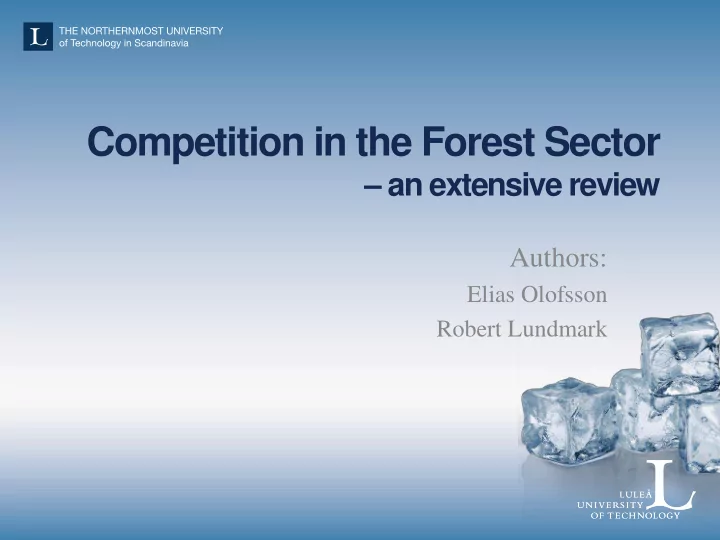

Competition in the Forest Sector – an extensive review Authors: Elias Olofsson Robert Lundmark
Competition in the Forest Sector • Competition = “Black sheep” • Assume perfect competition
Theoretical implication of noncompetitive markets • Price ≠ Marginal cost • Supply ↓ • Efficiency implications – effect bioproducts • High social costs
Objectives • Review and assess the current state of knowledge • How has competition has been implemented in forest sector models • Forest markets = competitive or noncompeititve?
The organization The competitive situation in forest markets The Roundwood market Backstop Markets How competition is handled in Forest Sector Models The Pulpwood market Law of one Price Cross-price effect Horizontal and Vertical The Sawtimber market integration
General noncompetition studies Roundwood market Pulpwood market Sawtimber market
Arguments for noncompetitive markets Number of buyers and sellers Regional Long-term and inelastic delivery supply Economies High sunk- of scale cost production High transportation cost of feedstock
Arguments against noncompetitive markets High Large losses High transport concentration ≠ from shutting cost Noncompetitive down Forest owners Complex associations decisions (FOAs)
General results from studies indicating noncompetitive markets
General results from studies indicating noncompetitive markets • The degree of market power vary over time – unstable purchasing cartel – firms only utilize their market power during recessions
Backstop markets & Law of one price
Backstop markets • Alternative market to ordinary market – access to a backstop market • Existence of backstop markets may allow firms to behave noncompetitively
Backstop markets “When small volumes are imported with a high price, this tends to keep the domestic price level at a lower level compared to the case where all the volumes would be procured from domestic markets” Hautamaki et al. (2012, p. 437)
Example Backstop Wood consuming firm Price effects Backstop Ordinary feedstock market market
Example Backstop
Law of one price • The law of one price (LOP) – absence of transportation costs – identical goods cost the same • Integrated markets – single common market
Example LOP Wood consuming firm Price effects Backstop Ordinary feedstock market market Arbitrage
Law of one price “… segmented markets are less likely to be perfectly competitive and therefore may be subject to inefficiency. ” Toppinen & Toivonen (1998, p. 244).
Caveats: Law of one price • Integrated markets ≠ competitive equilibrium or efficient allocation • No definitive conclusions from price movements alone
General findings from Backstop market and Law of one price studies
General findings • Market integration is distance sensitive • Multiple markets simultaneously – ensuring long-run production and profitability • Investing in forestland – a way to increase (or retain) bargaining power
Forest sector models
Forest sector models • “a model [ … ] which takes into account both forestry and forest industries and the interaction between these two activities” A graphical example a forest sector model showing all sectors and material flows, as used in Sjølie et al. (2015).
General results forest sector models
Forest sector models Markets are generally assumed to be operating under perfect competition
Conclusions
Conclusions • Simultaneous and continuous decisions diminishes noncompetitive market outcomes • Markets = too complex • No conclusive results • Aggregated markets = competitive • Disaggregated markets = subject for noncompetitive behavior
Conclusions • Forest sector models are build upon pre-existing methodology • Greater dependency on woody feedstock in the future
Recommend
More recommend